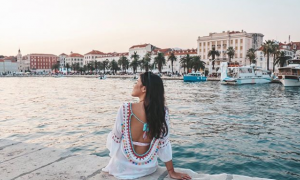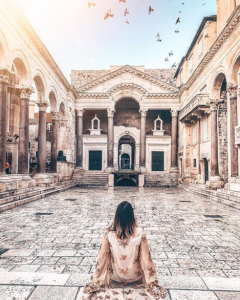
The Grad Split or the City of Split is located in the Republic of Croatia, in the South part of Europe. It currently occupies a small peninsula that can be found on the eastern portion of the Adriatic Sea. Being near this water formation, the City is quite conducive to water sports such as sailing, rowing and windsurfing, among others. With respect to its geographical coverage, Split is second to Zagreb as the largest city in Croatia. More importantly, it is the most significant and biggest city in Dalmatia alone, the latter being the administrative center of the Republic of Croatia.
A charming place that boasts of the Diocletian’s Palace, there is more to Split than its famous gravel and sand beaches plus sports centers. It has a small population that is a mere 5% of the 2007 figure in the whole of Croatia. A city preserved by the world heritage of UNESCO due to its various monuments and museums that underline its rich cultural and historical background, Split is certainly a tourist haven for those interested in archeology and history. As the spoken language in this city is limited to Croatian or Italian, you need to procure an English guide to maneuver yourself along the streets of Split to avoid getting lost.
The present composition of Split can be characterized to be a miniature structure of Croatia. The dominant citizens are Croats, which is estimated to be 95% of the total populace. The prevailing religion is Roman Catholicism similar to its parent country. The economy in Split can be described to be a developing market after recovering from a period of recession it has undergone during the past years. Things are beginning to look better starting 2005 when a new route was opened linking Split to the other freeway in the Croatian network. Trade and tourism are the City’s top two industries with the latte generating the much-needed revenue for the local government.

For the first time visitors to this Mediterranean place, the most notable museums you should go to would be the following – an Ethnographic museum, the Museum of Croatian Archeological Monuments, the Maestrovic Gallery, the Maritime Museum and the Croatian Museum. For a relaxing and leisurely vacation, the numerous beaches surrounding the city center can offer you all the amenities that you want. The local sights include the statues and cathedral that can be easily located within the city. Split celebrates the Split Music Festival and the Split Summer Theater Festival that highlights this City’s love for music and the entertainment arts.
Split is bustling with many athletic activities and greatly appeals to sports enthusiasts. You can choose from among the popular recreational pastimes to play basketball, football, handball, swimming, rowing, or sailing. In the field of tennis, Split has produced a tennis phenomenon in the person of Goran Ivanisevic who was a Wimbledon champion. Another tennis star in the making is Mario Ancic, also called “Super Mario” by his loyal fans. The city was also the site of the 1979 Mediterranean Games and the 1990 European Athletics Championships.
Definitely, Split has several things to offer for its booming tourism sector.
Top Sightseeing
- Diocletian’s palace and the monument of Grgur Ninski
- TROGIR – Trogir is a city of stones and arts
The Tourist Association of Trogir, Tel: 021/881-412 - Makarska
Makarska is one of the most attractive tourist destinations on the Croatian coast and is the heart of tourism in Dalmatia. Because of its good geographical position, it is an ideal place for holidays. One-day trips to Split, Brac, Hvar and Korcula are available from Makarska. The Makarska Riviera includes Brela, Baska Voda, Tucepi, Podgora, Zivogosce, Drvenik, Zaostrog and Gradac.
The Tourist Association of Makarska, Tel: 021/612-002 - Omis
Omis is situated at the mouth of the Cetina river, which flows into the sea through a “stone gate”.
The Tourist Association of the City of Omis, Tel: 021/861-350 - Vis
Vis is the most distant island of the region. It has 13 inhabited settlements, the largest being Vis and Komiza. - Bol
Bol is Brac’s oldest settlement. Its history dates back to the beginning of the Christian era. In many people’s opinion, Bol’s Zlatni Rat is the most beautiful beach on the Adriatic. The most famous nudist beach on Brac is Paklina, situated near Zlatni Rat.
Tel: 021/635-122 - Brac
Brac is the largest Central Dalmatian island and the third largest island in the Adriatic Sea. It has 22 inhabited towns and villages including Supetar, Sutivan, Bol, Povlja, Sumartin, Splitska, Milna and others, each being a special tourist attraction. Some of the most beautiful clerical residences and Renaissance and Baroque palaces have been built along the island’s famous picturesque bays with their sand and wild stone beaches made of hot Brac stone bathed in the crystal blue sea.
The Tourist Association of Zlatni Rat, Tel: 021/635-122
